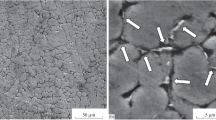Abstract
This paper describes the fundamental process of laser ablation occurring in a laser-induced plasma. The sampling process in laser-induced breakdown plasma spectrometry is very complicated and thus has not been fully understood. Our study focused on a relationship between the composition of ablation amounts and the bulk composition, when Fe-based binary alloys were employed as test samples. For this purpose, the ablation amounts of constituent elements in the alloys were determined by ICP-OES, through a method in which ablated deposits by laser irradiation were collected on a glass plate and then dissolved in an acid solution. In Fe-Ni binary alloys, the Ni content in the ablated deposits was almost the same as the bulk composition, which implied that Ni and Fe atoms evaporated along with the chemical composition of the samples; however, in Fe-Cr binary alloys, the Cr content in the ablated deposits was half of the bulk composition, probably because Cr atoms were difficult to be released from the sample surface. X-ray photoelectron spectra of ablated Fe-Cr alloy samples indicated that the resultant surface layer after laser irradiation comprised a thin oxide layer, consisting of Cr2O3 and FeO, and a relatively thick oxide layer beneath the outermost surface oxide, of which the composition was a complex of Cr2O3, Fe and FeO. The reason for this is that the dissociation energy of Cr2O3 is obviously higher than that of FeO, and thus Cr2O3 decomposed with more difficulty and thus left preferentially in a surface oxide layer of the Fe-Cr alloys. As a result, the Cr2O3 layer could suppress the ablation of Cr.
Similar content being viewed by others

References
K. Wagatsuma, Bunseki, 2006, 514.
E.H. Piepmeier, "Analytical Applications of Lasers", 1896, Wiley-Interscience, New York, 627.
D.A. Rusak, X. Mao, H. Liu, J. Gonzalez, S.S. Mao, Trac Trends Anal. Chem., 1998, 17(8), 453.
K. Kuzuya, M. Murakami, N. Maruyama, Spectrochim. Acta, Part B, 2003, 58, 957.
L. Zhang and K. Wagatsuma, ISIJ Int., 2013, 53(12), 2201.
R. Sattmann, V. Sturm, R. Noll, J. Phys. D, 1995, 28(10), 2181.
J. Sneddon, T.L. Thiem, Y-I. Lee, "Lasers in Analytical Atomic Spectroscopy", 1997, VCH Publishers, New York.
R.E. Russo, X.L. Mao, H.C. Liu, J. Gonzalez, S.S. Mao, Talanta, 2002, 57(3), 425.
S. Amoruso, R. Bruzzese, N. Spinelli, R. Velotta, J. Phys. B, 1999, 32(14), R131.
A. Miotello and R. Kelly, Appl. Phys. Lett., 1995, 67(24), 3535.
S. Amoruso, V. Berardi, R. Bruzzese, R. Velotta, N. Spinelli, X. Wang, Appl. Surf. Sci., 1999, 138, 250.
Y. Sasaki, H. Shimada, K. Wagatsuma, Anal. Sci., 2011, 27, 453.
S. Kashiwakura and K. Wagatsuma, Anal. Sci., 2013, 29(12), 1159.
G. Kasahara, S. Kashiwakura, K. Wagatsuma, Bunseki Kagaku, 2015, 64(1), 35.
M.P. Seah, Surf. Interface Anal., 2001, 31, 721.
D.A. Shirley, Phys. Rev., 1972, B5, 4709.
A. Proctor and P.M.A. Sherwood, Anal. Chem., 1982, 54, 13.
D. Briggs and M.P. Seah, "Practical Surface Analysis by Auger and X-ray Photoelectron Spectroscopy", 1983, John Wiley & Sons, Chichester, UK.
The Japan Institute of Metals and Materials, "Metal Data Book", 1974, Maruzen, Tokyo.
I. Barin, "Thermochemical Data of Pure Substances", 1995, VCH-Verlag, Weinheim.
S. Kashiwakura and K. Wagatsuma, ISIJ Int., 2015, 55(11), 2391.
D.A. Cremers, F.Y. Yueh, J.P. Singh, H. Zhang, "Encyclopedia of Analytical Chemistry", 2006, Wiley, New York.
D. Bulajic, M. Corsi, G. Cristoforetti, S. Legnaioli, V. Palleschi, A. Salvetti, E. Tognoni, Spectrochim. Acta, Part B, 2002, 57(2), 339.
J.M. Li, L.B. Guo, C.M. Li, N. Zhao, X.Y. Yang, Z.Q. Hao, Y.F. Lu, Opt. Lett., 2015, 40(22), 5224.
C.E. Moore, "Atomic Energy Levels", 1949 and 1953, Vols. 1-2, NBS Circular No. 467, U.S. Government Printing Office, Washington.
Author information
Authors and Affiliations
Corresponding author
Rights and permissions
About this article
Cite this article
Zhang, X., Kashiwakura, S. & Wagatsuma, K. Fundamental Study on Ablation Sampling of Fe-based Binary Alloys in Laser-induced Breakdown Optical Emission Spectrometry. ANAL. SCI. 33, 343–347 (2017). https://doi.org/10.2116/analsci.33.343
Received:
Accepted:
Published:
Issue Date:
DOI: https://doi.org/10.2116/analsci.33.343



